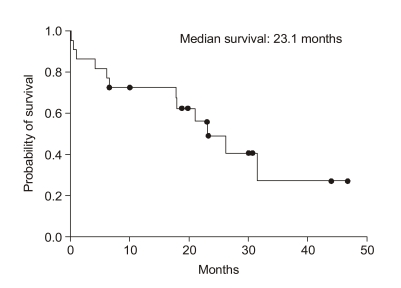Cancer Res Treat.
2007 Jun;39(2):65-68.
Clinical Characteristics of Primary Peritoneal Carcinoma
- Affiliations
-
- 1Division of Oncology, Department of Internal Medicine, College of Medicine, The Catholic University of Korea, Seoul, Korea. jhbyun37@yahoo.co.kr
Abstract
-
PURPOSE: The goal of this study was to determine the clinical and therapeutic characteristics of women with a primary peritoneal carcinoma (PPC).
MATERIALS AND METHODS
A retrospective clinical study was conducted to evaluate 22 women diagnosed with a PPC from 1993 to 2007 at the Hospitals of The Catholic University of Korea. Diagnoses were based on the Gynecologic Oncology Group criteria and clinical data. We collected patient clinicopathological data including age, presenting symptoms, pretreatment CA-125 values (U/ml), clinical stage (based on the FIGO stage), performance status (using the Eastern Cooperative Oncology Group scale), whether cytoreductive surgery was optimal or not, types of chemotherapy and response to treatment. We evaluated the clinical characteristics and response to treatment, time to treatment failure and overall survival.
RESULTS
The median overall survival of all patients was 23.1 months. The estimated 3-year survival rate was 29% (SE, 13%). The response rate to first-line platinum-based chemotherapy was 79% and the median time to treatment failure was 9.9 months (95% confidence interval, 1.38~18.4 months). By univariate and multivariate analysis, performance status was the only significant factor associated with overall survival (p<0.05).
CONCLUSION
We evaluated the clinical characteristics and treatment response of patients with a primary peritoneal carcinoma. Our results showed that it is possible to achieve long-term survival in patients with PPC. A further clinical study is to need to establish clinical characteristics and treatment outcomes.
MeSH Terms
Figure
Reference
-
1. Swerdlow M. Mesothelioma of the pelvic peritoneum resembling papillary cystadenocarcinoma of the ovary; case report. Am J Obstet Gynecol. 1959; 77:197–200. PMID: 13606191.2. Altaras MM, Aviram R, Cohen I, Cordoba M, Weiss E, Beyth Y. Primary peritoneal papillary serous adenocarcinoma: clinical and management aspects. Gynecol Oncol. 1991; 40:230–236. PMID: 2013445.
Article3. Fromm GL, Gershenson DM, Silva EG. Papillary serous carcinoma of the peritoneum. Obstet Gynecol. 1990; 75:89–95. PMID: 2296429.
Article4. Lele SB, Piver MS, Matharu J, Tsukada Y. Peritoneal papillary carcinoma. Gynecol Oncol. 1988; 31:315–320. PMID: 2458994.
Article5. Ransom DT, Patel SR, Keeney GL, Malkasian GD, Edmonson JH. Papillary serous carcinoma of the peritoneum. A review of 33 cases treated with platin-based chemotherapy. Cancer. 1990; 66:1091–1094. PMID: 2400962.
Article6. Bloss JD, Liao SY, Buller RE, Manetta A, Berman ML, McMeekin S, et al. Extraovarian peritoneal serous papillary carcinoma: a case-control retrospective comparison to papillary adenocarcinoma of the ovary. Gynecol Oncol. 1993; 50:347–351. PMID: 8406199.
Article7. Chu CS, Menzin AW, Leonard DG, Rubin SC, Wheeler JE. Primary peritoneal carcinoma: a review of the literature. Obstet Gynecol Surv. 1999; 54:323–335. PMID: 10234697.8. Cormio G, Di Vagno G, Di Gesu G, Mastroianni M, Melilli GA, Vimercati A, et al. Primary peritoneal carcinoma: a report of twelve cases and a review of the literature. Gynecol Obstet Invest. 2000; 50:203–206. PMID: 11014956.
Article9. Barda G, Menczer J, Chetrit A, Lubin F, Beck D, Piura B, et al. Comparison between primary peritoneal and epithelial ovarian carcinoma: a population-based study. Am J Obstet Gynecol. 2004; 190:1039–1045. PMID: 15118638.
Article10. WHO Handbook for Reporting Results of Cancer Treatment G. 1979. World Health Organization.11. Mills SE, Andersen WA, Fechner RE, Austin MB. Serous surface papillary carcinoma. A clinicopathologic study of 10 cases and comparison with stage III-IV ovarian serous carcinoma. Am J Surg Pathol. 1988; 12:827–834. PMID: 3189692.12. Dalrymple JC, Bannatyne P, Russell P, Solomon HJ, Tattersall MH, Atkinson K, et al. Extraovarian peritoneal serous papillary carcinoma. A clinicopathologic study of 31 cases. Cancer. 1989; 64:110–115. PMID: 2731107.
Article13. Weiss NS, Homonchuk T, Young JL Jr. Incidence of the histologic types of ovarian cancer: the U.S. Third National Cancer Survey, 1969~1971. Gynecol Oncol. 1977; 5:161–167. PMID: 881128.
Article14. Taus P, Petru E, Gucer F, Pickel H, Lahousen M. Primary serous papillary carcinoma of the peritoneum: a report of 18 patients. Eur J Gynaecol Oncol. 1997; 18:171–172. PMID: 9174828.15. Chen KT, Flam MS. Peritoneal papillary serous carcinoma with long-term survival. Cancer. 1986; 58:1371–1373. PMID: 3742460.
Article16. Bloss JD, Brady MF, Liao SY, Rocereto T, Partridge EE, Clarke-Pearson DL. Extraovarian peritoneal serous papillary carcinoma: a phase II trial of cisplatin and cyclophosphamide with comparison to a cohort with papillary serous ovarian carcinoma-a Gynecologic Oncology Group Study. Gynecol Oncol. 2003; 89:148–154. PMID: 12694669.
Article17. Skates S, Troiano R, Knapp RC. Longitudinal CA125 detection of sporadic papillary serous carcinoma of the peritoneum. Int J Gynecol Cancer. 2003; 13:693–696. PMID: 14675358.
Article18. Karlan BY, Baldwin RL, Lopez-Luevanos E, Raffel LJ, Barbuto D, Narod S, et al. Peritoneal serous papillary carcinoma, a phenotypic variant of familial ovarian cancer: implications for ovarian cancer screening. Am J Obstet Gynecol. 1999; 180:917–928. PMID: 10203660.
Article19. Truong LD, Maccato ML, Awalt H, Cagle PT, Schwartz MR, Kaplan AL. Serous surface carcinoma of the peritoneum: a clinicopathologic study of 22 cases. Human pathology. 1990; 21:99–110. PMID: 1688545.
Article




